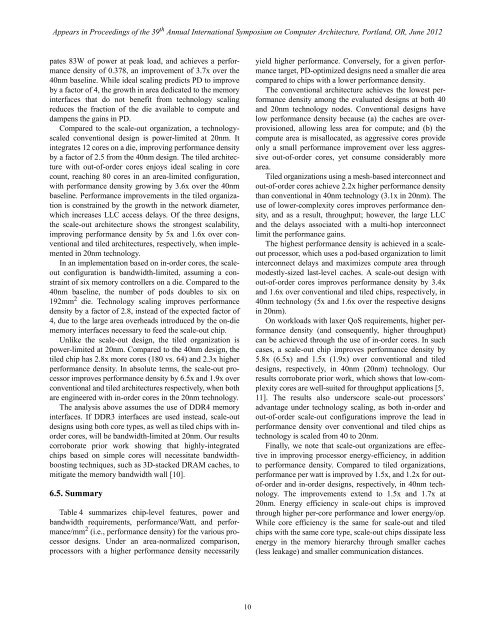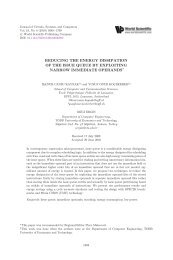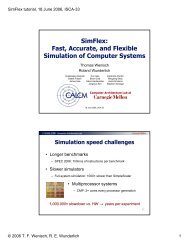Scale-Out Processors - PARSA - EPFL
Scale-Out Processors - PARSA - EPFL
Scale-Out Processors - PARSA - EPFL
Create successful ePaper yourself
Turn your PDF publications into a flip-book with our unique Google optimized e-Paper software.
Appears in Proceedings of the 39 th Annual International Symposium on Computer Architecture, Portland, OR, June 2012<br />
pates 83W of power at peak load, and achieves a performance<br />
density of 0.378, an improvement of 3.7x over the<br />
40nm baseline. While ideal scaling predicts PD to improve<br />
by a factor of 4, the growth in area dedicated to the memory<br />
interfaces that do not benefit from technology scaling<br />
reduces the fraction of the die available to compute and<br />
dampens the gains in PD.<br />
Compared to the scale-out organization, a technologyscaled<br />
conventional design is power-limited at 20nm. It<br />
integrates 12 cores on a die, improving performance density<br />
by a factor of 2.5 from the 40nm design. The tiled architecture<br />
with out-of-order cores enjoys ideal scaling in core<br />
count, reaching 80 cores in an area-limited configuration,<br />
with performance density growing by 3.6x over the 40nm<br />
baseline. Performance improvements in the tiled organization<br />
is constrained by the growth in the network diameter,<br />
which increases LLC access delays. Of the three designs,<br />
the scale-out architecture shows the strongest scalability,<br />
improving performance density by 5x and 1.6x over conventional<br />
and tiled architectures, respectively, when implemented<br />
in 20nm technology.<br />
In an implementation based on in-order cores, the scaleout<br />
configuration is bandwidth-limited, assuming a constraint<br />
of six memory controllers on a die. Compared to the<br />
40nm baseline, the number of pods doubles to six on<br />
192mm 2 die. Technology scaling improves performance<br />
density by a factor of 2.8, instead of the expected factor of<br />
4, due to the large area overheads introduced by the on-die<br />
memory interfaces necessary to feed the scale-out chip.<br />
Unlike the scale-out design, the tiled organization is<br />
power-limited at 20nm. Compared to the 40nm design, the<br />
tiled chip has 2.8x more cores (180 vs. 64) and 2.3x higher<br />
performance density. In absolute terms, the scale-out processor<br />
improves performance density by 6.5x and 1.9x over<br />
conventional and tiled architectures respectively, when both<br />
are engineered with in-order cores in the 20nm technology.<br />
The analysis above assumes the use of DDR4 memory<br />
interfaces. If DDR3 interfaces are used instead, scale-out<br />
designs using both core types, as well as tiled chips with inorder<br />
cores, will be bandwidth-limited at 20nm. Our results<br />
corroborate prior work showing that highly-integrated<br />
chips based on simple cores will necessitate bandwidthboosting<br />
techniques, such as 3D-stacked DRAM caches, to<br />
mitigate the memory bandwidth wall [10].<br />
6.5. Summary<br />
Table 4 summarizes chip-level features, power and<br />
bandwidth requirements, performance/Watt, and performance/mm<br />
2 (i.e., performance density) for the various processor<br />
designs. Under an area-normalized comparison,<br />
processors with a higher performance density necessarily<br />
yield higher performance. Conversely, for a given performance<br />
target, PD-optimized designs need a smaller die area<br />
compared to chips with a lower performance density.<br />
The conventional architecture achieves the lowest performance<br />
density among the evaluated designs at both 40<br />
and 20nm technology nodes. Conventional designs have<br />
low performance density because (a) the caches are overprovisioned,<br />
allowing less area for compute; and (b) the<br />
compute area is misallocated, as aggressive cores provide<br />
only a small performance improvement over less aggressive<br />
out-of-order cores, yet consume considerably more<br />
area.<br />
Tiled organizations using a mesh-based interconnect and<br />
out-of-order cores achieve 2.2x higher performance density<br />
than conventional in 40nm technology (3.1x in 20nm). The<br />
use of lower-complexity cores improves performance density,<br />
and as a result, throughput; however, the large LLC<br />
and the delays associated with a multi-hop interconnect<br />
limit the performance gains.<br />
The highest performance density is achieved in a scaleout<br />
processor, which uses a pod-based organization to limit<br />
interconnect delays and maximizes compute area through<br />
modestly-sized last-level caches. A scale-out design with<br />
out-of-order cores improves performance density by 3.4x<br />
and 1.6x over conventional and tiled chips, respectively, in<br />
40nm technology (5x and 1.6x over the respective designs<br />
in 20nm).<br />
On workloads with laxer QoS requirements, higher performance<br />
density (and consequently, higher throughput)<br />
can be achieved through the use of in-order cores. In such<br />
cases, a scale-out chip improves performance density by<br />
5.8x (6.5x) and 1.5x (1.9x) over conventional and tiled<br />
designs, respectively, in 40nm (20nm) technology. Our<br />
results corroborate prior work, which shows that low-complexity<br />
cores are well-suited for throughput applications [5,<br />
11]. The results also underscore scale-out processors’<br />
advantage under technology scaling, as both in-order and<br />
out-of-order scale-out configurations improve the lead in<br />
performance density over conventional and tiled chips as<br />
technology is scaled from 40 to 20nm.<br />
Finally, we note that scale-out organizations are effective<br />
in improving processor energy-efficiency, in addition<br />
to performance density. Compared to tiled organizations,<br />
performance per watt is improved by 1.5x, and 1.2x for outof-order<br />
and in-order designs, respectively, in 40nm technology.<br />
The improvements extend to 1.5x and 1.7x at<br />
20nm. Energy efficiency in scale-out chips is improved<br />
through higher per-core performance and lower energy/op.<br />
While core efficiency is the same for scale-out and tiled<br />
chips with the same core type, scale-out chips dissipate less<br />
energy in the memory hierarchy through smaller caches<br />
(less leakage) and smaller communication distances.<br />
10







